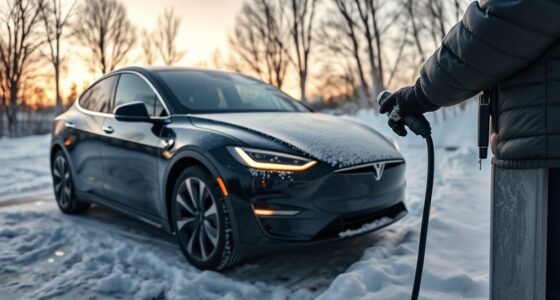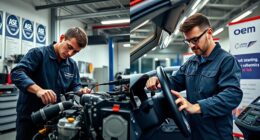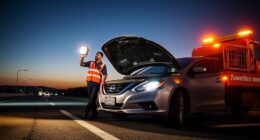Before hitting the road, make certain your vehicle is ready by checking tire pressure and tread, oil levels, brakes, and wipers. Pack a thorough emergency kit with jumper cables, a flashlight, first-aid supplies, blankets, snacks, and a phone charger. Doing these simple prep steps helps keep you safe and prevents unexpected breakdowns. Staying proactive with maintenance and supplies sets the stage for a smooth trip, and more safety tips await if you keep going.
Key Takeaways
- Perform a thorough vehicle inspection, including tire pressure, tread depth, oil level, brakes, and wipers, before starting your trip.
- Pack an emergency kit with jumper cables, flashlight, first-aid supplies, water, snacks, and a phone charger.
- Verify tire pressure and tread to ensure safety and optimal fuel efficiency during the trip.
- Confirm vehicle responsiveness—check brakes, oil, and wipers—to prevent breakdowns and maintain visibility.
- Prepare for weather changes and potential emergencies by bringing extra supplies and staying proactive with vehicle maintenance.

Are you ready to hit the open road and make the most of your holiday season? Before you start packing your bags and setting your GPS, it’s vital to verify your vehicle is in top shape. A well-maintained car isn’t just about comfort; it’s about safety. Take time to perform some basic vehicle maintenance. Check your tire pressure and tread depth—under-inflated tires can lead to poor fuel efficiency and increase the risk of a blowout. Inspect your oil level and top it off if necessary, because a smooth-running engine depends on proper lubrication. Don’t forget to confirm that your brakes are responsive and your windshield wipers are in good condition, especially if you’re traveling through winter weather where visibility can rapidly diminish. These small steps can prevent unexpected breakdowns and keep your trip stress-free.
Along with vehicle maintenance, packing an emergency kit should be at the top of your pre-trip checklist. An emergency kit is your safety net in case of accidents or mechanical failures. Make sure it includes essentials like jumper cables, a flashlight with extra batteries, basic tools, and a first-aid kit. Consider adding blankets, bottled water, non-perishable snacks, and a phone charger—especially if you’re venturing into areas with limited cell service. Having these supplies on hand means you’re prepared for the unexpected, whether it’s a flat tire, a dead battery, or getting stranded in bad weather. Keep your emergency kit easily accessible, ideally in the trunk or a designated compartment, so you can grab it quickly if needed.
Frequently Asked Questions
How Often Should I Check Tire Pressure Before a Long Trip?
You should check your tire pressure before every long trip to ensure essential tire pressure maintenance. A pre-trip tire inspection helps catch any issues early, preventing potential blowouts or uneven wear. Make it a habit to check your tire pressure at least once a month and before extended drives. Properly inflated tires improve fuel efficiency, safety, and handling, so don’t skip this vital step for a smooth, safe journey.
What Should I Do if My Car Overheats During the Trip?
If your car starts to overheat, stay calm and pull over safely. Turn off the engine and open the hood to let heat escape. Check your radiator inspection—look for leaks or low coolant levels. Avoid opening the radiator cap immediately, as hot steam can cause burns. Once cooled, add coolant if needed. If problems persist, call roadside assistance. Staying prepared helps you handle car overheating smoothly and safely.
Are There Specific Safety Features to Test Before Departure?
Before you leave, make sure to test key safety features. Check that your seat belt comfort is proper so you’ll actually wear it during the trip. Adjust and verify the blind spot mirrors give you a clear view of surrounding traffic. Guarantee all airbags are functional and brakes respond well. These checks help keep you safe and comfortable, making your road trip more enjoyable and secure.
How Can I Prevent Driver Fatigue on Long Drives?
To prevent driver fatigue on long drives, you should plan regular rest breaks every two hours to stay alert. Use hydration strategies like drinking water frequently to keep yourself refreshed, and avoid heavy meals that can make you sleepy. Also, share driving responsibilities if possible, and listen to engaging music or conversations. Staying attentive and taking timely breaks helps keep you safe and alert throughout your journey.
What Emergency Supplies Should I Carry in the Vehicle?
In emergencies, your vehicle becomes both a refuge and a risk. You should carry a well-stocked first aid kit to handle minor injuries and emergency tools like a flashlight, jumper cables, and a tire repair kit. These supplies prepare you for unexpected breakdowns or accidents, ensuring safety and quick response. Being equipped with these essentials transforms uncertainty into preparedness, giving you confidence to handle whatever comes your way on the road.
Conclusion
As you set off on your holiday adventure, remember that a little extra care in your car’s preparation can make all the difference. Think of it as giving your journey a gentle nudge towards smooth sailing. When your vehicle’s well-tuned and ready, you’ll find that even the most winding roads become easier to navigate. So, take those small steps now—your future self will thank you for a trip that’s nothing short of delightful. Safe travels!









